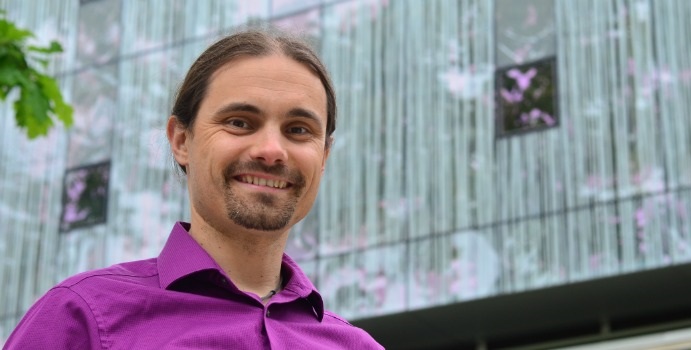June 10, 2015
A UBC electrical and computer engineering professor will be the first to teach a new online lab course that sees students build and test a computer chip in just six weeks. The course, starting July 7 on edX – an online learning platform – is designed to have students learn the basics of silicon photonics, an emerging field in the computing world. In this Q&A, Lukas Chrostowski discusses the applications of silicon photonics and what the future holds for this technology.
What is silicon photonics?
Photons are the building blocks of light. Silicon photonics is a technology that uses light, instead of electricity, to transfer data among computer chips. Because optical rays can move much more data, and move it much faster than electrical conductors, your device would require less energy but have exponentially more functions than devices with traditional chips.
Where can we find this technology being used?
Photonics chips are already being used in data centres. I imagine as the technology becomes more widely adopted it will become cheaper and gain new applications.
There are two main benefits of photonic chips. The first is much higher communication speeds. The other, which is probably more important, is lower energy consumption. Computers use power to communicate, and some estimates put this energy requirement at 3 per cent of the world’s power consumption. Ten years from now, we could be using huge amounts of power for communication, so there needs to be dramatic reductions in power. Optics has the promise of reducing that power consumption.
What’s different about your course?
The philosophy of the course is to get people as quickly as possible through the full design cycle of a photonics chip, which typically takes up to about a year. The students will learn design, circuit layout and modelling in just one to three weeks, and have their designs tested by us and then fabricated using a $5 million state of the art facility at the University of Washington.
The real key is the fabrication and experimentation piece that no other course offers. You’ll be able to check your theory by comparing it to experimental results which we’ll give you. If you’re just learning equations, it’s harder to get inspired. Here you see the fruits of your labours. You go through the math, you go through the modelling and you actually get the answer when you compare it to your model.
UBC professional education series on edX
Silicon photonics design is one of five professional education courses offered by UBC on edX:
Marketing for Non-Marketers – June 16
Silicon Photonics Design, Fabrication and Data Analysis – July 7
Innovation and Problem Solving through Creativity – Sept. 8
Policy Analysis Using Interrupted Time Series – Sept. TBD
Customer Insight through Qualitative Research – Oct. 20
“Face-to-face and online education channels have their unique strengths,” says UBC computer science professor and edX lead Gregor Kiczales. “With edX, professionals can access different kinds of continuing education from UBC in ways appropriate to the content, their schedules and where they live.”















